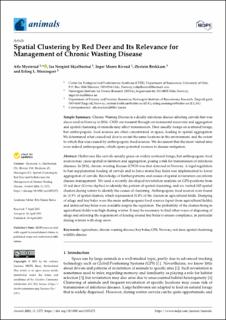| dc.contributor.author | Mysterud, Atle | |
| dc.contributor.author | Skjelbostad, Isa Nergård | |
| dc.contributor.author | Rivrud, Inger Maren | |
| dc.contributor.author | Brekkum, Øystein | |
| dc.contributor.author | Meisingset, Erling L. | |
| dc.date.accessioned | 2021-12-21T10:09:04Z | |
| dc.date.available | 2021-12-21T10:09:04Z | |
| dc.date.created | 2021-05-06T13:22:58Z | |
| dc.date.issued | 2021-04-28 | |
| dc.identifier.citation | Animals. 2021, 11 (5), . | en_US |
| dc.identifier.issn | 2076-2615 | |
| dc.identifier.uri | https://hdl.handle.net/11250/2835209 | |
| dc.description.abstract | Herbivores like cervids usually graze on widely scattered forage, but anthropogenic food sources may cause spatial revisitation and aggregation, posing a risk for transmission of infectious diseases. In 2016, chronic wasting disease (CWD) was first detected in Norway. A legal regulation to ban supplemental feeding of cervids and to fence stored hay bales was implemented to lower aggregation of cervids. Knowledge of further patterns and causes of spatial revisitation can inform disease management. We used a recently developed revisitation analysis on GPS-positions from 13 red deer (Cervus elaphus) to identify the pattern of spatial clustering, and we visited 185 spatial clusters during winter to identify the causes of clustering. Anthropogenic food sources were found in 11.9% of spatial clusters, which represented 31.0% of the clusters in agricultural fields. Dumping of silage and hay bales were the main anthropogenic food sources (apart from agricultural fields), and unfenced hay bales were available despite the regulation. The probability of the clusters being in agricultural fields was high during winter. It may be necessary to find other ways of disposing of silage and enforcing the requirement of fencing around hay bales to ensure compliance, in particular during winters with deep snow. | en_US |
| dc.language.iso | eng | en_US |
| dc.publisher | MDPI, Basel, Switzerland | en_US |
| dc.rights | Navngivelse 4.0 Internasjonal | * |
| dc.rights.uri | http://creativecommons.org/licenses/by/4.0/deed.no | * |
| dc.title | Spatial clustering by red deer and its relevance for management of chronic wasting disease | en_US |
| dc.type | Peer reviewed | en_US |
| dc.type | Journal article | en_US |
| dc.description.version | publishedVersion | en_US |
| dc.rights.holder | © 2021 by the authors | en_US |
| dc.source.pagenumber | 13 | en_US |
| dc.source.volume | 11 | en_US |
| dc.source.journal | Animals | en_US |
| dc.source.issue | 5 | en_US |
| dc.identifier.doi | 10.3390/ani11051272 | |
| dc.identifier.cristin | 1908509 | |
| dc.relation.project | Norges forskningsråd: 318575 | en_US |
| dc.source.articlenumber | 1272 | en_US |
| cristin.ispublished | true | |
| cristin.fulltext | original | |
| cristin.qualitycode | 1 | |

